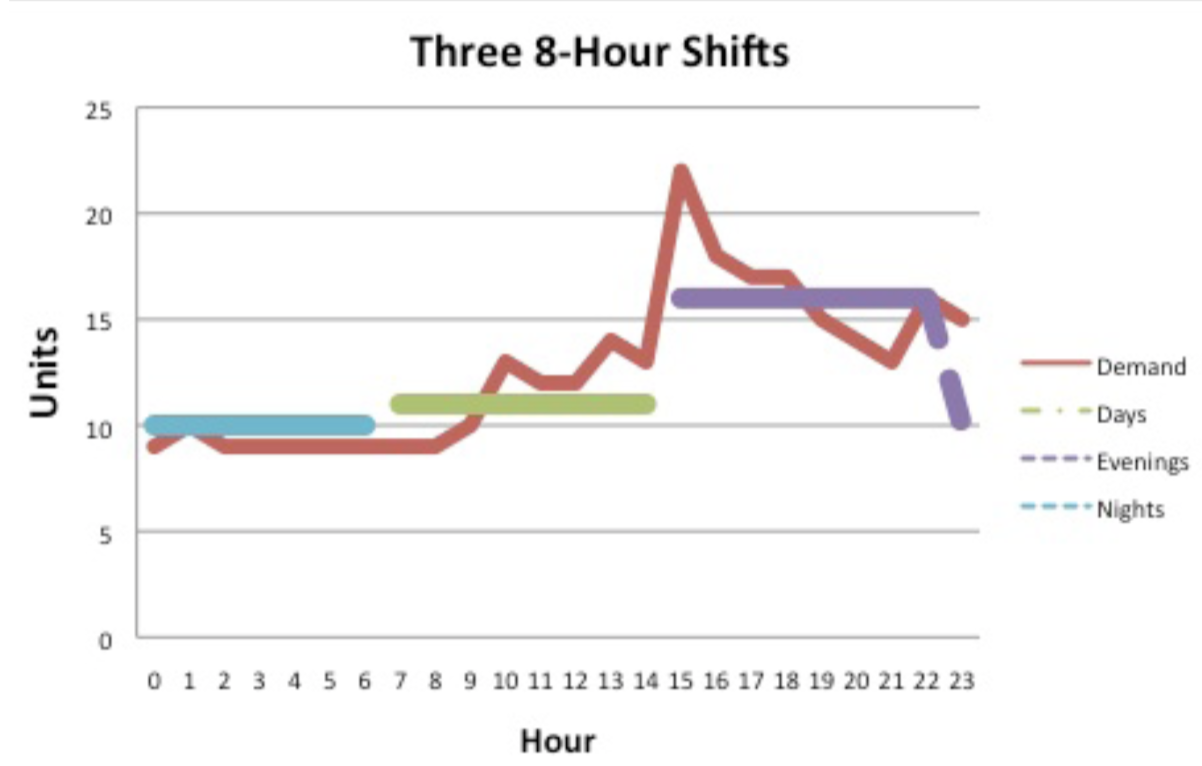Police Staffing, Scheduling and Deployment Services (720) 685-9550
10-Hour Shifts: Expensive Luxury, or Effective Deployment?
by Dale Harris Long a favorite of shift workers, the 10-hour shift has also frequently been the subject of management complaints about the difficulty of matching on-duty staffing to workload over the 24-hour day and seven-day week. A recent report from the Police Foundation titled The Shift Length Experiment has added new empirical evidence to support the staff preferences, but the challenge remains to justify the schedule. We will answer that challenge here.
To cover the 24-hour day with 8-hour shifts, one needs at least three shifts per day starting eight hours apart. Given that workload varies continuously during the day, and given that with this plan the on-duty staffing can change no more than three times per day, then there must be periods of time when the staffing level is either above or below the demand.

Shown here is a simplified chart of a 24- hour period with three standard 8-hour shifts. Even though the staffing for each shift is optimized to match the demand, there are very few times when the staffing matches the demand. The day shift (0700-1500) is overstaffed at the beginning, then significantly understaffed by the end. The evening shift (1500-2300) is severely understaffed at the beginning but then overstaffed later. The night shift (2300- 0700), like the evening shift, is understaffed at the beginning, and then slightly overstaffed later on.
For this demand profile, the apparent resolution would be to add an overlapping, or “cover” shift during the busy periods. However, doing so would not only place more staff than necessary on duty during several hours of that overlap, it would take staff away from other hours when they are needed more.
The 10-hour shift offers one resolution to this problem. Because there are at least 30 shift-hours scheduled per day (3 shifts * 10 hours) there are six hours per day to use for overlap(s) during busy times. The six hours of overlap do not have to be consecutive. For example, in the below chart the Day shift works from 0700-1700, the Evening shift works from 1400- 2400, and the night shift works from 2200-0800. This design creates overlaps between 1400-1700 and 2200-2400 which are peak demand periods for this agency. On this chart, note how the total on-duty units closely follow the demand profile improving efficiency and officer safety.
A further benefit of the 10-hour plan is that one shift does not end just as the next one begins. Followed strictly on an 8-hour plan there is the strong possibility that no units would be on the street, in their beats, and available to respond to calls that come in at shift change. Most 10-hour plans have at least a one-hour overlap as one shift ends and the next begins. This schedule gives the officers time to fuel their cars, return to the station and complete paperwork without incurring overtime and without leaving the beats unstaffed. For the oncoming shift, there is time for a briefing, preparing the vehicle, and driving to the beat, available for calls.
The Hidden 7% Bonus

Officers working a 10-hour plan work four shifts per week, while those on an 8-hour plan work five. Typically, a police shift begins with a briefing or roll call consuming about 30 minutes before the officer is on the street and ready for calls. There is one hour of breaks during the shift, and then the last 30 minutes are consumed by paperwork and other end-of-shift activities. Altogether two hours out of each shift is lost to active patrol work. For a four-day week, that is eight hours. And for a five-day week, it is ten. The net gain in patrol time is nearly seven percent. That may not sound like much, but consider if you have 100 patrol officers this is the equivalent of adding seven more at no cost.
Happier and Healthier Cops
According to the Shift Length Experiment* staff working four 10-hour shifts “averaged significantly more sleep and reported experiencing a better quality of work life than did their peers working 8-hour shifts. And officers working 12- hour shifts experienced greater levels of sleepiness (a subjective measure of fatigue) and lower levels of alertness than those assigned to 8-hour shifts. Importantly, those on 8-hour shifts averaged significantly less sleep per 24-hour period and worked significantly more overtime hours than those on 10- or 12-hour shifts” (abstract p. iv).
Having at least a portion of the weekend off is one of the chief interests we find when we work with agencies across North America. For most agencies, Friday and Saturday nights are busy times for police work, so there is a built-in conflict. 10-hour, 4-day schedules tend to make it more likely that each officer will regularly have at least part of the weekend off.
Most officers commute to work, and driving four times per week is naturally 20% less costly not only in travel expenses but also in time.
Overall, it appears that 10-hour shifts are beneficial to the officers, management and the community. The essential step in implementing and managing a 10-hour plan is the analysis and optimization.
*The Shift Length Experiment, Amendola, Karen L, Police Foundation, 2011.

